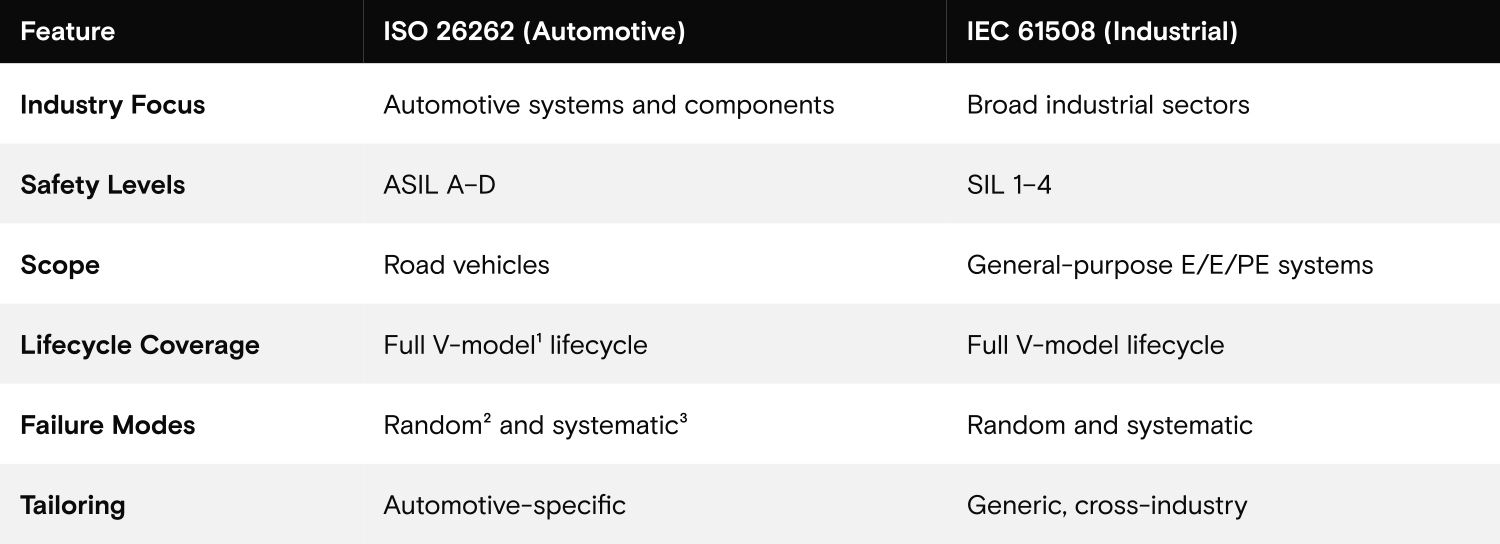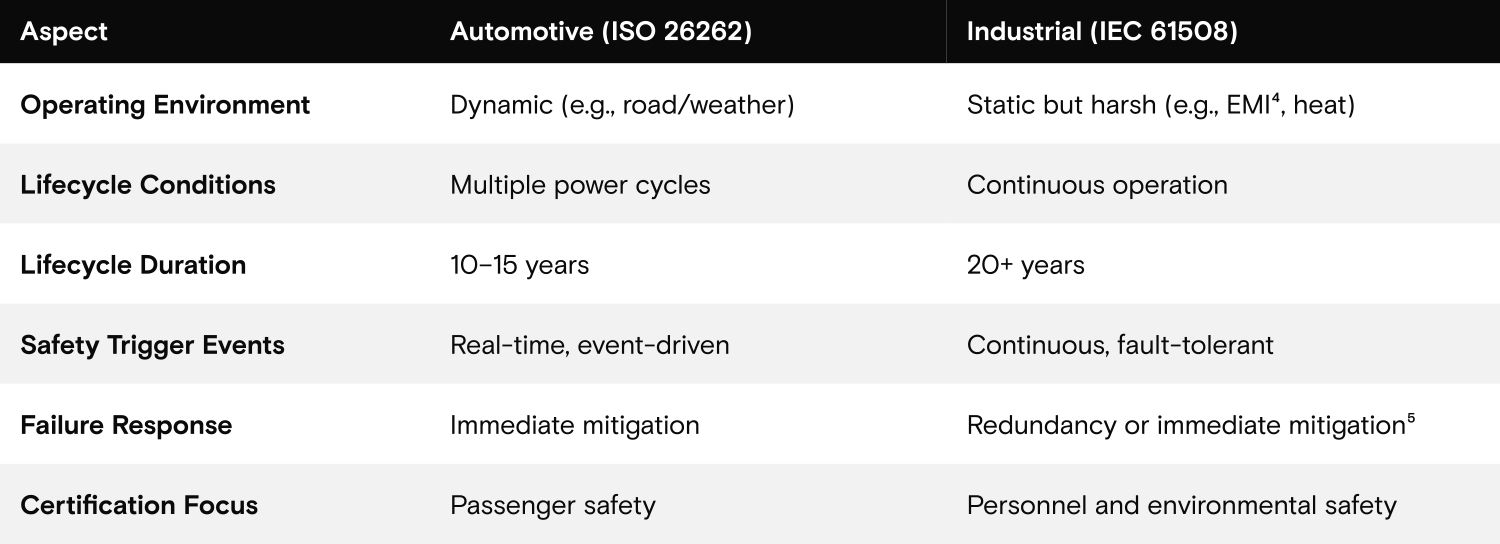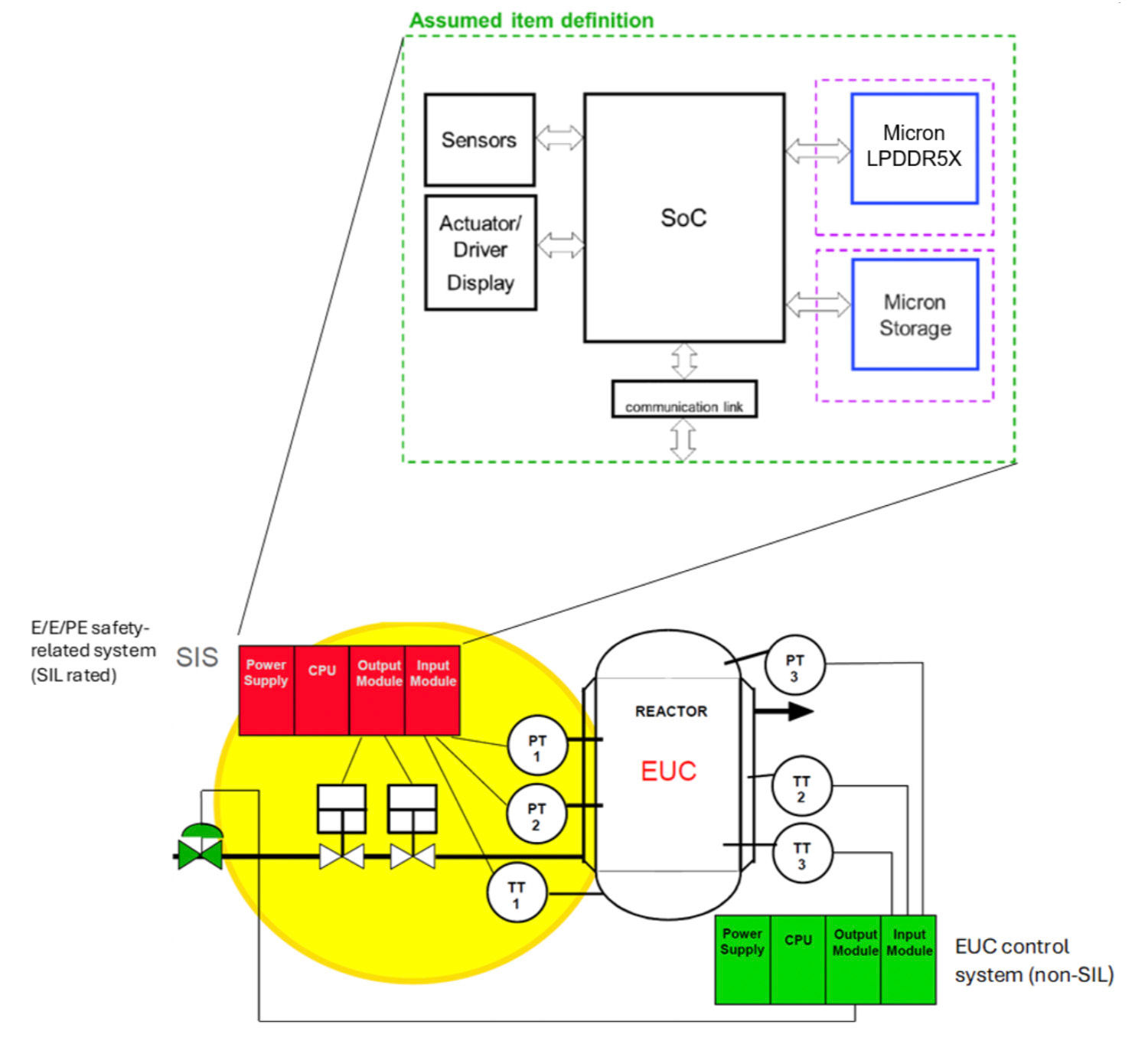Invalid input. Special characters are not supported.
Micron extends functional safety leadership from automotive to industrial markets
Those of us who enjoy the convenience and usefulness of cars, rockets, robots and airplanes expect that they are safe — perhaps even taking safety for granted. But for the designers of these systems, safety and subsequent requirements are crucial to the function of their products.
For over three decades, Micron has been a trusted leader in the automotive memory and storage market, delivering innovations that meet the evolving demands of chipset (SoC) vendors, OEMs, tier 1 suppliers and end users. Our legacy of excellence in quality and safety has made us a benchmark in the industry. We understand that it’s vital for both auto and mission-critical industrial applications to use leading-edge memory designed to support functional safety standards and to help integrators significantly reduce development time and simplify safety system certifications.
Defining functional safety
The objective of Functional safety is that a system will continue to operate safely and correctly in response to its inputs — even when faults occur. In the context of semiconductors, functional safety involves designing and validating components to detect, manage and mitigate failures that could otherwise lead to hazardous conditions. Industry standards such as ISO 26262 for automotive systems and IEC 61508 for industrial applications define the structured processes and safety integrity levels — Automotive Safety Integrity Level (ASIL) and Safety Integrity Level (SIL) — that guide the development of these safety-critical components.
Recognizing the role of memory in auto safety systems
With the rapid evolution of advanced driver-assistance systems (ADAS) and autonomous driving, the complexity of vehicle electronics has reached levels comparable to modern data centers. Memory components — once considered peripheral — have become central to the performance and safety of these systems.
In 2022, Micron became the first in the industry to achieve ISO 26262 ASIL-D certification for LPDDR5X DRAM, setting a new benchmark for functional safety in memory. This milestone redefined memory as a complex semiconductor, placing it on equal footing with processors and SoCs in safety-critical applications. More than a technical achievement, it signalled Micron’s strategic commitment to enabling safe, reliable performance across ADAS, infotainment and autonomous driving platforms.
Today, Micron remains the only memory vendor offering product-level ASIL-D-certified DRAM — reinforcing our leadership in functional safety. As we expand into industrial markets, this legacy of safety and reliability positions Micron as a trusted supplier in sectors undergoing rapid transformation, where both safety and performance are non-negotiable.
Elevating industrial safety with IEC 61508 SIL-3 certification
The industrial sector is undergoing a profound digital transformation, fuelled by smart factories, robotics and edge AI. These advancements bring new levels of complexity and criticality, demanding safety standards on par with those in the automotive industry. As industrial automation systems scale across manufacturing, energy and transportation, the potential impact of failures becomes increasingly significant. Systems that manage machinery, infrastructure or mobility must be designed to fail safely — starting with components that meet rigorous SIL standards.
To address this need, Micron is expanding its ASIL-D-capable LPDDR5X portfolio to meet Safety Integrity Level 3 (SIL 3) requirements, reinforcing our commitment to functional safety across both automotive and industrial domains. Our LPDDR5X product series has achieved IEC 61508 certification at SIL 3 for systematic capability, as assessed by exida. This milestone enables Micron to deploy our memory solutions in mission-critical industrial applications that require the highest levels of safety assurance.
Micron’s LPDDR5X solutions now support SIL-3 compliance at the system level with external safety mechanisms and SIL-2 compliance using internal safety features alone.
In 2022, Micron achieved both a product certificate and a process certificate for ISO 26262. While the product certificate validated our ability to deliver an ASIL-compliant memory solution, the process certificate was even more strategic—it confirmed that our development processes themselves are capable of consistently producing ASIL-compliant products. This distinction enables us to scale functional safety across our automotive portfolio.
We are now applying the same approach to the industrial domain. By certifying a representative LPDDR5X product under IEC 61508 (detailed below), and pairing it with a process certification, we are establishing a foundation for broader proliferation. This means that future Micron products developed using these certified processes can inherit IEC 61508 compliance more efficiently, accelerating time to market and reducing the burden of re-certification for each new product.
As with our automotive offerings, Micron equips industrial customers with safety documentation — including safety manuals and FMEDA-based safety analysis reports (Table 1). Availability of these resources enables transparency, traceability and ease of integration into safety-critical designs.
In an era where industrial systems are becoming increasingly intelligent and autonomous, SIL-rated memory is not optional: It’s foundational.
Understanding IEC 61508
As mentioned above, ISO 26262 standards apply to automotive systems while IEC 61508 is a globally recognized standard for enabling the functional safety of electrical, electronic and programmable electronic (E/E/PE) systems (Table 2). It provides a system-based, risk-driven framework applicable across a wide range of industrial sectors — from factory automation and robotics to medical devices, railways and energy systems. It also serves as the foundation for sector-specific standards such as IEC 61511 (process industries), IEC 62061 (machinery) and IEC 61800-5-2 (power drives).
In IEC 61508, the mode of operation of a safety function determines how its reliability is assessed and how SILs are calculated. There are three modes:
- Low demand mode: Activated infrequently, typically no more than once a year (for example, emergency shutdowns).
- High demand mode: Activated frequently, possibly more than once a year (for example, safety interlocks).
- Continuous mode: Always active, continuously maintaining a safe state (for example, real-time control systems).
Micron LPDDR5X memory is designed to support the continuous mode, the most stringent case, enabling real-time fault detection and mitigation in mission-critical industrial systems.
By adopting IEC 61508, Micron enables industrial customers to meet safety goals with confidence while supporting regulatory compliance and supply chain efficiency.
While ISO 26262 and IEC 61508 share a common foundation in functional safety principles, they use modes that differ significantly due to the nature of their respective environments (Table 3).
These differences mean that industrial systems often require broader interoperability, longer lifecycle support and more flexible fault handling. By achieving IEC 61508 SIL-3 certification, Micron demonstrates that its memory solutions are not only robust enough for automotive-grade safety but also adaptable to the unique demands of mission-critical industrial automation, robotics and control systems.
Micron LPDDR5X products meet target random hardware fault (RHWF) metrics (Table 4) in these ranges:
- Few FIT (SIL-2) with internal safety measures
- Few tenths of FIT (SIL-3 system) with external safety mechanisms
These metrics align with ISO 26262 ASIL-C and ASIL-D targets.
Seeing a SIL-3-certified solution in action
Micron LPDDR5X memory is a key enabler in E/E/PE safety-related systems, providing reliable storage for safety-critical code, parameters and real-time data. While it is commonly used alongside CPUs and logic control functions — as illustrated in the SoC subsystem in Figure 1 — it is equally effective in input/output modules, smart transmitters and sensors, and the control logic of final elements. Designed with SIL-3-certified systematic capability, Micron memory enables high-integrity data flow with robust error detection and mitigation. All stored data is treated as safety-critical and protected by extensive safety measures to prevent, detect and control faults — supporting a wide range of safety functions across both centralized and distributed architectures.
Micron LPDDR5X products are designed for use in the continuous mode of operation to help trigger a risk-reduction measure at any moment during the lifetime of the overall system. This design enables an adequate fault detection and reaction time to prevent a dangerous event occurrence. Continuous mode is the most stringent case as it restricts applicable safety measures to those that operate continuously during system run time, excluding any that rely on periodic offline maintenance or diagnostic interruptions.
Our groundbreaking LPDDR5X-optimized error correction code (ECC) scheme mitigates system in-line ECC penalties, delivering up to a 15% to 25% bandwidth increase.7 This new LPDDR5X-optimized ECC scheme — called direct link ECC protocol (DLEP) — not only delivers increased performance but also helps LPDDR5X memory systems achieve the ISO 26262 ASIL-D and IEC 61508 SIL-3 hardware metric through reduced failures in time (FIT). Additionally, this new product delivers approximately 10% lower power consumption on a pJ/b (picojoule-per-bit) perspective and a minimum 6% additional addressable memory space.
Sharing a unified vision for embedded safety
Micron’s strategy is clear — to be the reference supplier for safety-compliant memory and storage solutions across both automotive and industrial markets. Our unified framework integrates ISO 26262 and IEC 61508 standards, highlighting a safety mindset.
We continue to invest in infrastructure, including a dedicated Functional Safety Office that implements safety packages and first-level support with training materials for our customers. While customers are responsible for meeting their own system-level safety targets, we provide expert guidance on the role of memory in achieving functional safety.
For automotive customers, this expansion reinforces our commitment to delivering some of the safest memory solutions available. For industrial customers, it marks a new era — bringing Micron’s proven safety, reliability and innovation to mission-critical industrial systems.
Whether you're designing the next generation of autonomous vehicles or building high-reliability industrial systems, Micron is your trusted supplier for safety.
Learn more about Micron’s automotive memory and storage, in addition to key topics related to our commitment to safety and security.
1 A development model that maps system design (left side of the "V") to corresponding validation and verification activities (right side of the “V”), emphasizing traceability and structured testing.
2 Unpredictable hardware failures that occur due to defectivity, radiation or other physical effects. Addressed through redundancy and diagnostic mechanisms.
3 Design or process-related errors that consistently occur under specific conditions. Mitigated through rigorous development processes and verification.
4 To be assessed at system level.
5 Automotive systems often require immediate action while industrial systems may rely on redundancy or graceful degradation. For industrial, at system level, redundancy is expected, multichannel operation is required, and maintenance could be possible on one line while the other is continuing to provide the safety function.
6 PFH: probability of dangerous failure per hour; 1 FIT is one failure per 109 hours. PFH is the requirement for the overall system. Usually, the FIT is allocated to all components of the system, and we have historically assumed for our memories a small percentage of the overall FIT budget, typically a few percentage points.
7 LPDDR5X with enhanced ECC for automotive rises to the challenge.








